| Listing 1 - 9 of 9 |
Sort by
|
Book
ISSN: 19683553 ISBN: 9782701805535 2701805538 Year: 2018 Volume: 22 Publisher: Paris De Boccard
Abstract | Keywords | Export | Availability | Bookmark
 Loading...
Loading...Choose an application
- Reference Manager
- EndNote
- RefWorks (Direct export to RefWorks)
Conferences - Meetings --- Copts --- Antiquities --- Antiquités coptes. --- Coptes. --- Excavations (Archaeology) --- Egypt --- Copts - Congresses. --- Excavations (Archaeology) - Egypt - Congresses. --- Egypt - Antiquities - Congresses.
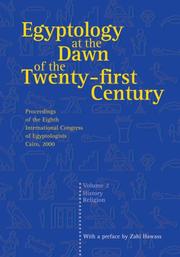
ISBN: 9774246748 9774247140 9774247159 9789774246746 Year: 2003 Publisher: Le Caire New York American university in Cairo press
Abstract | Keywords | Export | Availability | Bookmark
 Loading...
Loading...Choose an application
- Reference Manager
- EndNote
- RefWorks (Direct export to RefWorks)
Egyptology --- Egyptologie --- Conferences - Meetings --- Excavations (Archaeology) --- Fouilles (Archéologie) --- Congresses --- Congrès --- Egypt --- Egypte --- Civilization --- Congresses. --- History --- Antiquities --- Civilisation --- Histoire --- Antiquités --- To 332 B.C. --- Egyptian language --- Archaeological museums and collections --- Collection and preservation --- Excavations (Archaeology) - Egypt - Congresses.
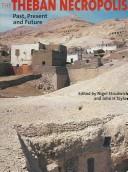
ISBN: 0714122475 9780714122472 Year: 2003 Publisher: Londres British Museum press
Abstract | Keywords | Export | Availability | Bookmark
 Loading...
Loading...Choose an application
- Reference Manager
- EndNote
- RefWorks (Direct export to RefWorks)
Tombs --- Excavations (Archaeology) --- Tombes --- Fouilles (Archéologie) --- Congresses. --- Congrès --- Thebes (Egypt : Extinct city) --- Thèbes (Egypte : Ville ancienne) --- Congresses --- Fouilles (Archéologie) --- Congrès --- Thèbes (Egypte : Ville ancienne) --- Archaeological digs --- Archaeological excavations --- Digs (Archaeology) --- Excavation sites (Archaeology) --- Ruins --- Sites, Excavation (Archaeology) --- Archaeology --- Thebes (Egypt : Ancient city) --- Egypt --- Antiquities --- Tombs - Egypt - Congresses --- Excavations (Archaeology) - Egypt - Congresses
Book
ISSN: 11106441 ISBN: 9782111298545 2111298549 Year: 2015 Volume: 34 Publisher: Alexandrie Centre d'études alexandrines
Abstract | Keywords | Export | Availability | Bookmark
 Loading...
Loading...Choose an application
- Reference Manager
- EndNote
- RefWorks (Direct export to RefWorks)
Les Actes du colloque international La batellerie égyptienne organisé par le Centre d'Études Alexandrines (USR 3134 du CNRS) mettent en évidence les caractéristiques propres de la batellerie égyptienne qui ne saurait totalement se confondre avec la batellerie nilotique. S'y ajoute celle des grands lacs situés au nord du Delta ainsi que le réseau complexe des communications mettant en jeu le fleuve, les lacs et les canaux. Pour faire apparaître les particularités et les permanences, l'étude porte sur la longue durée, de l'Égypte pharaonique aux temps modernes, et fait appel aussi bien aux sources archéologiques, historiques, philologiques et papyrologiques qu'ethnographiques. Sur une telle durée, seuls des éclairages significatifs ont été privilégiés pour leur exemplarité et leur capacité à établir des passerelles entre les diverses époques. À cet égard, la confrontation entre les différentes sources apparaît ici dans toute son originalité et sa richesse, en ouvrant de nombreuses perspectives de recherche.
Navigation --- Excavations (Archaeology) --- Shipping --- Ships, Ancient --- Fouilles (Archéologie) --- Transports maritimes --- Navires anciens --- History --- Congresses --- Histoire --- Congrès --- Nile River --- Egypt --- Nil (Fleuve) --- Egypte --- History, Naval --- Antiquities --- Histoire navale --- Antiquités --- Transports de navigation intérieure --- Bateaux de rivière --- Navigation intérieure --- Archéologie sous-marine --- Fouilles (Archéologie) --- Congrès --- Antiquités --- Inland water transportation --- Underwater archaeology --- Congresses. --- Inland water transportation - Egypt - Congresses --- Excavations (Archaeology) - Egypt - Congresses --- Underwater archaeology - Egypt - Congresses
Book
ISBN: 9783700179542 3700179545 9783447111836 3447111836 Year: 2018 Volume: 5 83 Publisher: Vienna Austrian Academy of Sciences Press
Abstract | Keywords | Export | Availability | Bookmark
 Loading...
Loading...Choose an application
- Reference Manager
- EndNote
- RefWorks (Direct export to RefWorks)
The study of the semiotics of palaces in the Ancient Near East and Ancient Egypt provides the historian with diverse information as size and type of architecture demonstrate the kind of representation chosen by rulers towards their world. Some features were adopted from temples in order to stage the appearance of the ruler like a divine epiphany. Some further integrate a temple within the palace, showcasing the desire of the ruler to live with a specific deity under one roof for divine support and protection. The importance of this ruler can also be reflected by the size of the throne room and the number of columns, showing as well a hierarchy in the use of space within the whole building complex and its different units. For instance, the presence of a rather intimate throne room or a second small throne room points to space for confidential exchange between the ruler and his visitors. The capacity of storerooms additionally gives us insight into the economic power standing behind the palace. The comparison of different elements between palatial and domestic architecture also proves helpful in identifying the origins of particular components.0Exploration of such semiotics was initiated with the publication of the first palace volume in 2018 (Verlag der ÖAW, Vienna) following a conference held in London 2013. The present volume stands in direct continuation and is the result of a second palace conference that took place at the 10th ICAANE 2016 in Vienna. Besides introducing other palaces in Egypt and Nubia, this volume is dedicated primarily to Near Eastern palaces which are presented and studied by prominent experts in this field.
Palaces --- Architecture, Ancient --- Excavations (Archaeology) --- Egypt --- Middle East --- Antiquities. --- Archaeological digs --- Archaeological excavations --- Digs (Archaeology) --- Excavation sites (Archaeology) --- Ruins --- Sites, Excavation (Archaeology) --- Archaeology --- Buildings --- Conferences - Meetings --- Antiquities --- Palaces - Middle East - Congresses --- Palaces - Egypt - Congresses --- Architecture, Ancient - Middle East - Congresses --- Architecture, Ancient - Egypt - Congresses --- Excavations (Archaeology) - Middle East - Congresses --- Excavations (Archaeology) - Egypt - Congresses --- Egypt - Antiquities --- Middle East - Antiquities --- Architecture antique --- Architecture, Ancient. --- Excavations (Archaeology). --- Palaces. --- Egypt. --- Middle East. --- Ancient Egypt (region). --- Middle East (general region).
Book
ISSN: 26278022 ISBN: 9783447111836 3447111836 3447198516 Year: 2019 Volume: 8 Publisher: Vienna Austrian Academy of Sciences Press
Abstract | Keywords | Export | Availability | Bookmark
 Loading...
Loading...Choose an application
- Reference Manager
- EndNote
- RefWorks (Direct export to RefWorks)
The study of the semiotics of palaces in the Ancient Near East and Ancient Egypt provides the historian with diverse information as size and type of architecture demonstrate the kind of representation chosen by rulers towards their world. Some features were adopted from temples in order to stage the appearance of the ruler like a divine epiphany. Some further integrate a temple within the palace, showcasing the desire of the ruler to live with a specific deity under one roof for divine support and protection. The importance of this ruler can also be reflected by the size of the throne room and the number of columns, showing as well a hierarchy in the use of space within the whole building complex and its different units. For instance, the presence of a rather intimate throne room or a second small throne room points to space for confidential exchange between the ruler and his visitors. The capacity of storerooms additionally gives us insight into the economic power standing behind the palace. The comparison of different elements between palatial and domestic architecture also proves helpful in identifying the origins of particular components.Exploration of such semiotics was initiated with the publication of the first palace volume in 2018 following a conference held in London 2013. The present volume stands in direct continuation and is the result of a second palace conference that took place at the 10th ICAANE 2016 in Vienna. Besides introducing other palaces in Egypt and Nubia, this volume is dedicated primarily to Near Eastern palaces which are presented and studied by prominent experts in this field.
Conferences - Meetings --- Architecture égyptienne --- Architecture --- Actes de congrès. --- Architecture égyptienne --- Architecture, Ancient --- Palaces --- Excavations (Archaeology) --- Antiquities. --- Architecture, Ancient. --- Palaces. --- Egypt --- Middle East --- Egypt. --- Middle East. --- Antiquities --- Archaeology --- E-books --- Architecture, Ancient - Middle East - Congresses --- Architecture, Ancient - Egypt - Congresses --- Palaces - Middle East - Congresses --- Palaces - Egypt - Congresses --- Excavations (Archaeology) - Middle East - Congresses. --- Excavations (Archaeology) - Egypt - Congresses --- Egypt - Antiquities --- Middle East - Antiquities --- Architecture antique --- Excavations (Archaeology). --- Fouilles archéologiques --- Palais --- Moyen-Orient --- Égypte --- Antiquités.
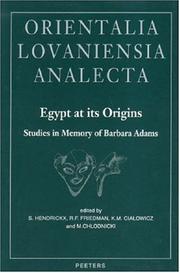

ISBN: 9042914696 9789042914698 Year: 2004 Volume: 138 Publisher: Leuven Peeters
Abstract | Keywords | Export | Availability | Bookmark
 Loading...
Loading...Choose an application
- Reference Manager
- EndNote
- RefWorks (Direct export to RefWorks)
This volume, published in memory of Barbara Adams, presents 57 contributions by authors from 16 different countries and contains the results of the latest research on Predynastic and Early Dynastic Egypt. In addition to papers originally presented at the 2002 conference in Krakow, there are the invited contributions by the friends and colleagues of Barbara Adams, including several on new discoveries from and thoughts about the site of Hierakonpolis.
Excavations (Archaeology) --- Fouilles (Archéologie) --- Congresses. --- Congrès --- Adams, Barbara, --- Egypt --- Egypte --- Antiquities --- History --- Antiquités --- Histoire --- Academic collection --- Conferences - Meetings --- Fouilles (Archéologie) --- Congrès --- Antiquités --- Archaeological digs --- Archaeological excavations --- Digs (Archaeology) --- Excavation sites (Archaeology) --- Ruins --- Sites, Excavation (Archaeology) --- Archaeology --- Égypte --- Ägypten --- Egitto --- Egipet --- Egiptos --- Miṣr --- Southern Region (United Arab Republic) --- Egyptian Region (United Arab Republic) --- Iqlīm al-Janūbī (United Arab Republic) --- Egyptian Territory (United Arab Republic) --- Egipat --- Arab Republic of Egypt --- A.R.E. --- ARE (Arab Republic of Egypt) --- Jumhūrīyat Miṣr al-ʻArabīyah --- Mitsrayim --- Egipt --- Ijiptʻŭ --- Misri --- Ancient Egypt --- Gouvernement royal égyptien --- جمهورية مصر العربية --- مِصر --- مَصر --- Maṣr --- Khēmi --- エジプト --- Ejiputo --- Egypti --- Egypten --- מצרים --- United Arab Republic --- Excavations (Archaeology) - Egypt - Congresses --- Egypt - Antiquities - Congresses --- Egypt - History - To 332 B.C. - Congresses
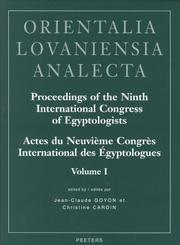
ISBN: 9789042917170 9042917172 Year: 2007 Volume: 150 Publisher: Leuven Peeters
Abstract | Keywords | Export | Availability | Bookmark
 Loading...
Loading...Choose an application
- Reference Manager
- EndNote
- RefWorks (Direct export to RefWorks)
Excavations (Archaeology) --- Academic collection --- Archaeological digs --- Archaeological excavations --- Digs (Archaeology) --- Excavation sites (Archaeology) --- Ruins --- Sites, Excavation (Archaeology) --- Archaeology --- Egypt --- Égypte --- Ägypten --- Egitto --- Egipet --- Egiptos --- Miṣr --- Southern Region (United Arab Republic) --- Egyptian Region (United Arab Republic) --- Iqlīm al-Janūbī (United Arab Republic) --- Egyptian Territory (United Arab Republic) --- Egipat --- Arab Republic of Egypt --- A.R.E. --- ARE (Arab Republic of Egypt) --- Jumhūrīyat Miṣr al-ʻArabīyah --- Mitsrayim --- Egipt --- Ijiptʻŭ --- Misri --- Ancient Egypt --- Gouvernement royal égyptien --- جمهورية مصر العربية --- مِصر --- مَصر --- Maṣr --- Khēmi --- エジプト --- Ejiputo --- Egypti --- Egypten --- מצרים --- United Arab Republic --- Antiquities --- Civilization --- Conferences - Meetings --- Fouilles (Archéologie) --- Congresses. --- Congrès --- Egypte --- Antiquités --- Civilisation --- Congresses --- To 332 B.C. --- 332 B.C.-638 A.D. --- Excavations (Archaeology) - Egypt - Congresses --- Egypt - Antiquities - Congresses --- Egypt - Civilization - To 332 B.C. - Congresses --- Egypt - Civilization - 332 B.C.-638 A.D. - Congresses
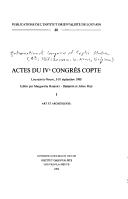
ISBN: 9068313150 9068313568 9789068313567 9789068313154 Year: 1992 Volume: 40-41 Publisher: Louvain UCL. Institut orientaliste
Abstract | Keywords | Export | Availability | Bookmark
 Loading...
Loading...Choose an application
- Reference Manager
- EndNote
- RefWorks (Direct export to RefWorks)
Archeologie --- Archéologie --- Art --- Colloques --- Colloquia --- Kunst --- Art, Coptic --- -Christian art and symbolism --- -Coptic language --- -Excavations (Archaeology) --- -Gnosticism --- -Manichaeism --- -Academic collection --- Dualism (Religion) --- Philosophy, Ancient --- Egyptian language --- Archaeological digs --- Archaeological excavations --- Digs (Archaeology) --- Excavation sites (Archaeology) --- Ruins --- Sites, Excavation (Archaeology) --- Archaeology --- Art, Christian --- Art, Ecclesiastical --- Arts in the church --- Christian symbolism --- Ecclesiastical art --- Symbolism and Christian art --- Religious art --- Symbolism --- Church decoration and ornament --- Congresses --- Christianity --- Coptic Church --- -Church of Egypt --- Alexandria (Egypt : Coptic Patriarchate) --- Coptic Patriarchate of Alexandria --- Coptic Church. --- Coptic Orthodox Patriarchate of Alexandria --- Baṭriyarkīyat al-Aqbāṭ al-Urthūdhuks --- Coptic Orthodox Church --- Kanīsah al-Qibṭīyah al-Urthūdhuksīyah --- Kanīsah al-Masīḥīyah bi-Miṣr --- Kanīsah al-Qibṭīyah --- Koptische Kirche --- الكنيسة القبطية --- كنيسة الاقباط الأرثوذكس --- كنيسة القبطية --- كنيسة القبطية الارثوذكسية --- Egypt --- Égypte --- Ägypten --- Egitto --- Egipet --- Egiptos --- Miṣr --- Southern Region (United Arab Republic) --- Egyptian Region (United Arab Republic) --- Iqlīm al-Janūbī (United Arab Republic) --- Egyptian Territory (United Arab Republic) --- Egipat --- Arab Republic of Egypt --- A.R.E. --- ARE (Arab Republic of Egypt) --- Jumhūrīyat Miṣr al-ʻArabīyah --- Mitsrayim --- Egipt --- Ijiptʻŭ --- Misri --- Ancient Egypt --- Gouvernement royal égyptien --- جمهورية مصر العربية --- مِصر --- مَصر --- Maṣr --- Khēmi --- エジプト --- Ejiputo --- Egypti --- Egypten --- מצרים --- United Arab Republic --- Antiquities --- -Congresses. --- Religion --- Conferences - Meetings --- Coptic language --- Congresses. --- Christian art and symbolism --- Excavations (Archaeology) --- Manichaeism --- Gnosticism --- Coptic art --- Copts --- Coptic literature --- Coptic philology --- Art [Coptic ] --- Cults --- Symbolism in art --- Gnosticisme --- Christian art and symbolism - Egypt - Congresses --- Art, Coptic - Congresses --- Excavations (Archaeology) - Egypt - Congresses --- Coptic language - Congresses --- Manichaeism - Egypt - Congresses --- Gnosticism - Egypt - Congresses --- Copte (langue) --- Eglise copte --- Manicheisme --- -Congresses --- Art copte
| Listing 1 - 9 of 9 |
Sort by
|

 Search
Search Feedback
Feedback About UniCat
About UniCat  Help
Help News
News